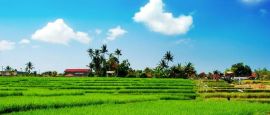Laos History, Language and Culture
History of Laos
Laos' history is shaped by kingdoms, empires, and a persistent sense of independence that has helped it maintain a distinct identity in Southeast Asia. The country's earliest civilisations emerged along the fertile banks of the Mekong River, where small principalities thrived on trade between India and China. By the 14th century, these fragmented states united under King Fa Ngum to form the Kingdom of Lan Xang, or the "Land of a Million Elephants". Centred in Luang Prabang, Lan Xang grew into one of Southeast Asia's most powerful kingdoms, blending Theravada Buddhism with animist traditions that still influence Lao culture today.
For over three centuries, Lan Xang flourished as a hub of art, architecture, and religion. Its temples and palaces reflected a prosperous, cultured society, but internal rivalries and foreign incursions eventually led to its fragmentation in the 18th century. By the early 19th century, Laos had become a pawn between neighbouring Siam (Thailand) and Vietnam, before falling under French control as part of Indochina in the late 1800s. The French introduced new infrastructure and architecture — much of which remains visible in Vientiane and Luang Prabang — but rural life continued largely unchanged, bound to the rhythms of the rice fields and the river.
During the mid-20th century, Laos found itself at the crossroads of global conflict. Following World War II, the country gained independence in 1953, but its strategic position along the Ho Chi Minh Trail made it a focal point of the Vietnam War. Between 1964 and 1973, Laos became the most heavily bombed country per capita in history, as the United States attempted to disrupt North Vietnamese supply lines. Even today, unexploded ordnance (UXO) remains scattered across rural areas, and organisations continue the painstaking task of clearing them to make the land safe again.
In 1975, after years of civil conflict, the monarchy was abolished and the Lao People's Democratic Republic was established under communist rule. Since then, the country has maintained political stability and gradually opened its economy to tourism and trade, while preserving much of its traditional way of life.
Did you know?
• Laos is the most heavily bombed country per capita in history, with millions of unexploded ordnances still being cleared today.
• The Mekong River runs for more than 1,800km through Laos, shaping its geography and daily life.
• Sticky rice is so central to Lao culture that the Lao word for "eat" literally means "to eat rice."
Language in Laos
The official language of Laos is Lao, a tonal language closely related to Thai. It uses its own script, which is derived from ancient Khmer, though in tourist areas you will also find signs in both Lao and English. In Vientiane, Luang Prabang and other major destinations, many people working in tourism, hospitality and transport speak at least some English, while in rural areas communication may rely more on gestures and smiles than words.
French, a legacy of the colonial era, is still spoken by some older Lao and in government or academic circles, though its use is declining. In border regions, it's common to hear Thai, Vietnamese and various ethnic minority languages, reflecting the country's diverse population. Learning a few simple Lao phrases such as "Sabaidee" (hello) and "Khop chai" (thank you) is always appreciated and helps travellers connect more warmly with locals.




 You know where
You know where